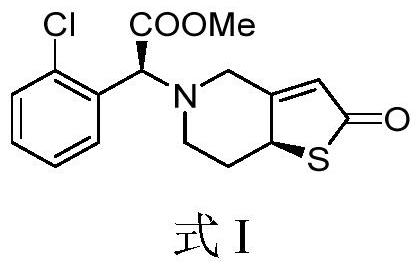Solid preparation containing insoluble thienopyridine composition and preparation method thereof
A technology for solid preparations and compositions, which is applied in the field of solid preparations and preparations containing insoluble thienopyridine compositions, can solve the problems of slow dissolution rate and reduced bioavailability, and achieves low production cost, improved dissolution rate, suitable for effect on industrial production
- Summary
- Abstract
- Description
- Claims
- Application Information
AI Technical Summary
Problems solved by technology
Method used
Image
Examples
Embodiment 1
[0040] This embodiment discloses the preparation method of the compound of formula II, specifically:
[0041] (S)-2-(2-chlorophenyl)-2-(7a-hydroxy-2-oxo-2,6,7,7a-tetrahydrothieno[3,2-c]pyridine-5(4H )-base) Synthesis of methyl acetate
[0042] Step 1. Synthesis of IM1:
[0043]
[0044] At room temperature, slowly drop 35 mL of anhydrous THF suspension with 7.1 g of sodium hydride into 586 mL of anhydrous THF dissolved with 58.6 g of SM1, stir for 30 min, then slowly drop into 70 mL of anhydrous THF with 69.2 g of SM2 dissolved therein and Stir at room temperature for 12 h, and monitor the reaction by TLC iodine display. After the reaction was completed, 650 mL of saturated brine was added and extracted with 1500 mL of DCM. Organic layer with Na 2 SO 4 After drying, the solvent was removed by evaporation under reduced pressure. The residue was purified on a silica gel column to obtain 52.3 g (62.3% yield) of IM1 as a colorless oily liquid (PE / EA=20 / 1 to 5 / 1). LC-MS(E...
Embodiment 2
[0057] Embodiment 2: the research of the different ratio of formula II compound and formula I compound
[0058] In this example, the pure products of the compound of formula I and compound of formula II in the thienopyridine composition with different proportions were added to conduct research to investigate their quality stability. Specifically: using the same amount of thienopyridine composition and auxiliary materials, only the ratio of the formula II compound to the formula I compound is different, and the same preparation method is used to make tablets. The content of the related substances was determined on the tablet at 0 days and accelerated at 6 months. Its prescription composition is calculated by 1000 tablets, as shown in Table 1:
[0059] Table 1 Prescription Composition Table 1
[0060]
[0061]
[0062] The preparation method is:
[0063] 1. Weigh the pure products of the compound of formula I and the compound of formula II respectively; after mixing eve...
Embodiment 3
[0075] Embodiment 3: control the ratio of II compound and formula I compound, refined preparation method
[0076] Prepare the crude compound shown in I according to the method disclosed in Example 2 of CN 104245707, take 1.0g of the crude compound shown in formula I and put it into a 50mL eggplant-shaped bottle, add 30mL tetrahydrofuran, heat up to 60°C and stir to dissolve, basically dissolve, and heat Filtrate, stir the filtrate in a 50mL beaker, and slowly cool down to room temperature, stir overnight to crystallize, and dry to obtain 0.38g of the finished compound. The mass ratio of the compound II to the compound of formula I in the finished product is less than or equal to 0.5:100, which can be refined repeatedly. Thereby further reducing the mass ratio of the II compound to the formula I compound.
[0077] The assay method of formula II compound and formula I compound is as follows:
[0078] Amylose-tris(3,5-xylylcarbamate) was used as filler, n-hexane-isopropanol-abso...
PUM
 Login to View More
Login to View More Abstract
Description
Claims
Application Information
 Login to View More
Login to View More - R&D
- Intellectual Property
- Life Sciences
- Materials
- Tech Scout
- Unparalleled Data Quality
- Higher Quality Content
- 60% Fewer Hallucinations
Browse by: Latest US Patents, China's latest patents, Technical Efficacy Thesaurus, Application Domain, Technology Topic, Popular Technical Reports.
© 2025 PatSnap. All rights reserved.Legal|Privacy policy|Modern Slavery Act Transparency Statement|Sitemap|About US| Contact US: help@patsnap.com



